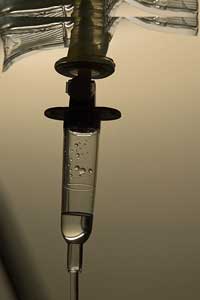It is the most effective treatment for severe ME/CFS that I have found in my 21 years of looking….Dr. David Bell 2006
Saline solution is…
an intravenous IV drip containing sodium chloride (salt water) at levels close to those found in the blood (usually 0.9%). Saline solution raises blood volume levels; a common need in a disorder where patients are often a liter or more down in blood volume. It may also effect the functioning of the autonomic nervous system which has been implicated in chronic fatigue syndrome, fibromyalgia and similar other disorders.
Outside of chronic fatigue syndrome (ME/CFS) saline solution is typically used in emergency situations when blood volume drops enough (hypovolemia) to significantly impair blood circulation.
Check out an effective way to measure blood volume in ME/CFS.
Measuring Blood Volume in Chronic Fatigue Syndrome – the Daxor Way
Saline is often used – when ME/CFS patients are able to get it – to counter the effects of a crash. Staci Stevens of Workwell recommends saline after exercise testing. It may be particularly effective when taken before and after surgery at reducing the side effects of anesthesia.
Saline Solution May Be Effective in Chronic Fatigue Syndrome (ME/CFS) and POTS Because…
While it’s clear that saline IV’s raise the blood volume allowing more blood to get to the tissues, organs and brain, other methods of increasing blood volume have failed to produce same results. Why saline IV’s can have such beneficial effects in some is a mystery.
Studies
Twelve hundred mg. sodium chloride daily for eight weeks enabled half the chronic fatigue syndrome patients with orthostatic hypotension (low blood pressure upon standing) who failed a tilt table test to pass it in a 1997 study.
Burklow et. al found providing saline to adolescents who had fainted during a tilt table test, enabled all of them to pass successfully pass a 30 minute tilt table test without fainting. Heart rate variability tests suggested the saline stopped the sympathetic nervous system crash the adolescents were experiencing.
A 2014 study found that IV saline significantly increased cardiovascular performance (increased stroke volume and cardiac output and reduced systemic vascular resistance) but did not increase exercise capacity (VO2peak, peak HR) in POTS. A 2017 study found that intermittent saline IV’s over a year significantly reduced symptoms and improved quality of life in postural orthostatic tachycardia syndrome (POTS) patients.
Regular Use of Saline May Reduce Symptoms, Boost Energy in POTS (and ME/CFS?)
Remarkably, 50% of the study participants didn’t feel they needed the IV’s anymore – suggesting that regular use of saline IV’s in POTS may be able to eradicate the disease in some. The authors believed the IV’s allowed the POTS patients to exercise, overcome the deconditioning present, and basically work their way out of the illness.
Oral rehydration solution is currently being evaluated in an NIH funded ME/CFS study and an IV albumin/saline study is underway in POTS.
Chronic Fatigue Syndrome (ME/CFS) Doctors Report
Dr. Bell noted that a year of daily 1 liter saline infusions had enabled a severely ill CFS patient who had been undergoing seizures (which had been characterized as psychological in nature) to return to full-time work.
With the first bag of saline the “pseudo-seizures” stopped and did not return. At three months of daily infusions of 1 liter of normal saline, she was able to be up and around the house for several hours a day. At six months of treatment she was able to volunteer at her church for three hours a day. At one year of infusions she returned to full time work and has remained working for nearly five years.
Saline solution’s effects are, however, usually temporary resulting in a return of symptoms when the treatment is stopped. Dr. Bell reported that 75% of the 25 patients he’d tried saline solution on had improved.
Many specialist ME/CFS practitioners including Dr. Peterson, Dr. Klimas and Dr. Bateman use saline solution.
Chronic Fatigue Syndrome Patients Report
Many people have reported significant increases in energy and reduced symptoms following saline. One person with ME/CFS suffering a severe relapse after being given general anesthesia for an operation reported being revived 5 weeks later after being given saline solution.
Another reported ME/CFS patient reported saline helped her recovery from surgery greatly…“
I recently had major surgery and was given IV saline continuously from pre-op until two days later when I left the hospital. It made all the difference in the world for me, I believe because it not only increased my blood volume but it also helped to flush out the effects of general anesthesia. As a result, I’m still recovering from the surgery but I did not experience any relapse in ME/CFS symptoms. Following the anesthesia protocol (always carry your laminated card and present it with your insurance card) is equally important but I can’t stress enough the benefits of IV saline before, during and after surgery.”
Risks
IV saline is not without its risks. If PICC lines (“permanently” placed catheter) are used they will likely cause an infection at some point. The woman who returned to health (see above) encountered no less than four infections over a year. Others have gone for over a year without an infection. Dr. Bell does not recommend changing the line every six weeks.
Resources
- Regular Use of Saline May Reduce Symptoms, Boost Energy in POTS (and ME/CFS?)
- Oral rehydration solution – an easier, cheaper, and more effective way to increase blood volume?
- A person with ME/CFS gets through three surgeries successfully while using saline.
- The Nitty Gritty on IV Saline and POTS / Speed and frequency – Does it Matter? – An Aussie blogs on her experiences with IV saline – lots of information here.
- Medications for Orthostatic Intolerance
- Dr. David Bell “Intravenous Fluid as a Treatment for ME/CFS”
- How to enhance blood volume
- How to measure blood volume accurately





